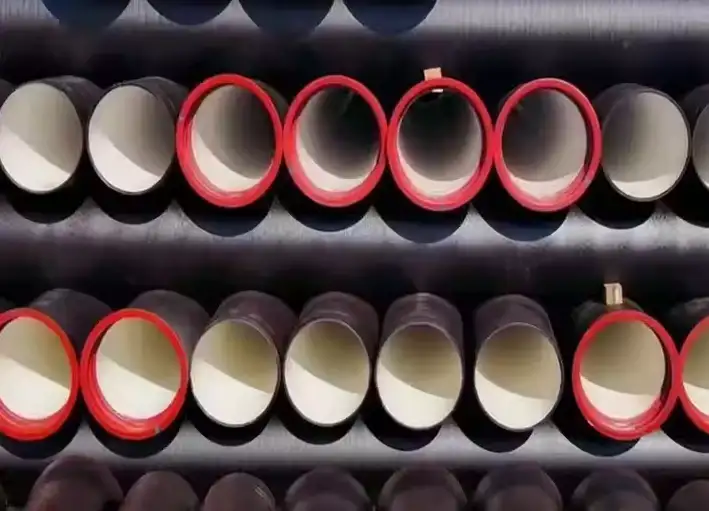Before diving into specifics, it’s essential to know that the “K” in ductile iron pipe stands for a thickness‐class coefficient defined by ISO 2531/EN 545, used in the formula
e=K×(0.5+0.001×DN)
where e is the nominal wall thickness (mm) and DN is the pipe’s nominal diameter (mm). Classes K7, K8, K9 and K12 represent increasing wall‐thickness levels, with K9 being the most commonly adopted “standard” class due to its balance of cost, strength and durability. Compared to pressure‐rated C‑series pipes, K‑series pipes are designed to resist both internal pressures and external loads (soil, traffic), making them ideal for buried mains. Thanks to robust linings and coatings—and when installed with proper backfill and polyethylene sleeving—Class K ductile iron pipelines reliably exceed 100 years of service life.

What is k in Ductile Iron Pipe?
-
K = Coefficient in the ISO 2531 thickness formula, accounting for mechanical loading as well as hydrostatic pressure.
-
A higher K yields a thicker wall, boosting pressure capacity and resistance to external loads.
-
Class K is purely a wall‐thickness designation, unlike Class C which is a working‐pressure designation.
Class K Series: Parameters & Comparison
Below is a quick comparison of Classes K7, K8, K9 and K12 at two representative diameters (DN). Values for K7 and K9 are drawn from ISO/EN tables (minimum nominal thicknesses), while K8 and K12 follow the ISO formula.
| Class | Formula | e @ DN 200 mm | e @ DN 300 mm |
|---|---|---|---|
| K7 | 7 × (0.5 + 0.001 × DN) | 4.9 mm (≈ 5 mm) | 5.6 mm |
| K8 | 8 × (0.5 + 0.001 × DN) | 5.6 mm | 6.4 mm |
| K9 | 9 × (0.5 + 0.001 × DN) | 6.3 mm | 7.2 mm |
| K12 | 12 × (0.5 + 0.001 × DN) | 8.4 mm | 9.6 mm |
Notes:
K7 @ DN 200/300: nominal 5.0 / 5.6 mm.
K9 @ DN 200/300: nominal 6.3 / 7.2 mm.
Minimum wall‑thickness requirements often apply (e.g. K7 ≥ 5 mm, K8 ≥ 6 mm) per ISO/IS guidelines.
Advantages of Class K Series
-
Superior Pressure Capacity
-
Thicker walls raise the burst and working‐pressure thresholds beyond equivalent C‑series grades.
-
-
Enhanced External‐Load Resistance
-
Engineered to handle soil weight, compaction, and traffic loads, reducing installation demands on bedding and backfill.
-
-
Uniform External Diameter
-
All classes share the same outside diameter for seamless joint compatibility and simpler maintenance.
-
-
Economic Lifecycle Cost
-
Though unit cost is higher, long service life and low maintenance yield excellent life‐cycle value.
-
Expected Service Life
-
Modern ductile iron pipes with cement‑mortar lining, zinc/epoxy coatings, and polyethylene sleeving in aggressive soils are designed for 100+ years of service.
-
Studies by the Ductile Iron Pipe Research Association (DIPRA) confirm century‑long performance under typical burial conditions.
FAQ
Q1: Why choose K9 over K7 or K8?
-
K9 offers a cost‑balanced thickness that meets most municipal potable‑water requirements without undue material expense; K7 and K8 are chosen only when loading conditions permit thinner walls.
Q2: Can I use Class K pipe in high-traffic areas?
-
Yes. K‑series pipe walls are sized to resist both internal pressure and external trench/traffic loads; select K‑value based on soil cover and traffic classification.
Q3: How does corrosion affect service life?
-
Proper linings/coatings mitigate corrosion. In benign soils, lifespans exceed 100 years; even in aggressive soils, polyethylene sleeving maintains long‑term integrity.
By understanding the “K” coefficient, designers ensure ductile iron pipelines deliver exceptional durability, strength and cost efficiency—often surpassing a century of reliable service.
References:
- ISO 2531:2009 – Ductile iron pipes, fittings, accessories and their joints for water applications
- EN 545 – Ductile iron pipes, fittings, accessories and their joints for water pipelines – Requirements and test methods
- DIPRA – Ductile Iron Pipe Overview and Advantages
- Wikipedia – Ductile Iron Pipe
- ISO 2531 – Wall Thickness Formula and Explanation (Annex D)

